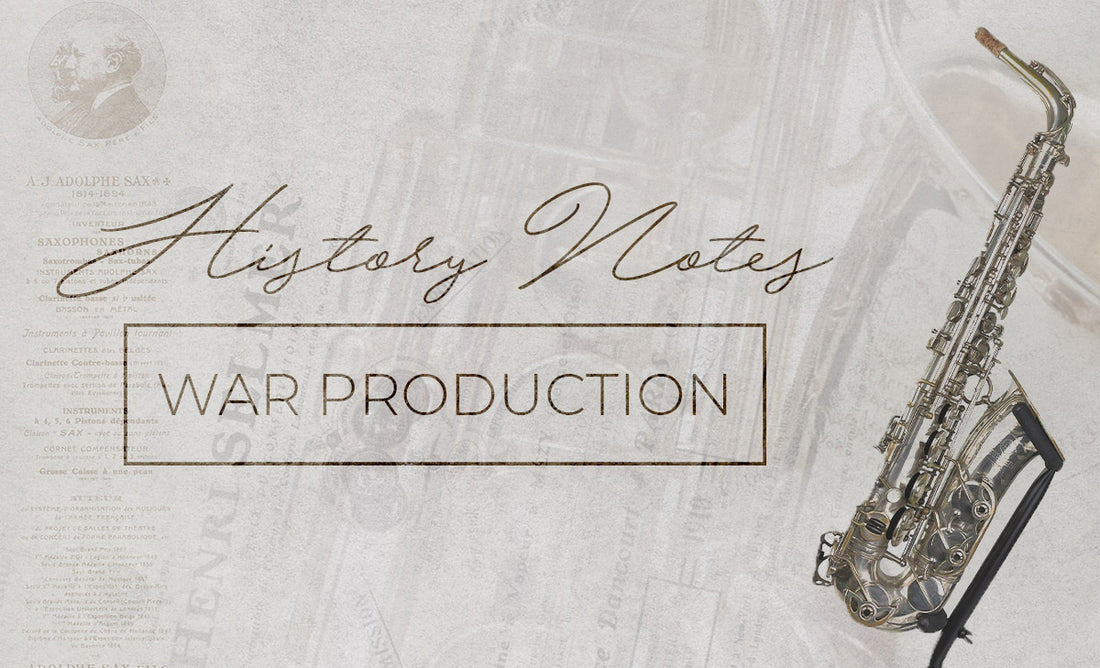History Notes #08 : Production during World War II

In 1939, Germany, France, and England all declared war on each other. On may 10th 1940 the Germans attacked through Belgium into France. On June 14th 1940, Paris fell to the Germans. We could think that production would likely stop cold, but amazingly, in a much smaller capacity, Henri SELMER Paris was able to produce musical instruments throughout the war.
 In the years leading up to the war, production was roughly about 2,000 instruments per year. During the war, production continued at about 400 to 500 per year. Most of the production was Altos, no bass, very few baritones. It makes sense, finding brass would be a real challenge. Many of the instruments were ones that would have been as samples or examples sitting around the factory. There were a number of instruments you would think would have been sold in the late twenties and early thirties that have dates of being sold in 1940 through 44.
In the years leading up to the war, production was roughly about 2,000 instruments per year. During the war, production continued at about 400 to 500 per year. Most of the production was Altos, no bass, very few baritones. It makes sense, finding brass would be a real challenge. Many of the instruments were ones that would have been as samples or examples sitting around the factory. There were a number of instruments you would think would have been sold in the late twenties and early thirties that have dates of being sold in 1940 through 44.
One of my personal favorite stories: Henri SELMER Paris sold instruments to British and Canadian prisoners of war in their prison camps. The prisoners would, through their commandant order an instrument for their prison band and Henri SELMER Paris would deliver it to them and paid for by the officers themselves.
 One interesting feature that is often associated with the wartime production is the appearance of black pearls, rather than actual Pearl, it's black rubber of plastic keys. What happened was Selmer supply of the key pearls was cut off during the war, and so they used up the instrument. Shortly before liberation, they ran out of the G sharp key, the Oval G sharp key. That was the only one that was actually a black key during wartime. It was in the fall of 1945 that most of the regular keys were replaced by the black and by late 1946 and even a few examples sold into early 1947. Some of these black keys remain. So for collectors out there, that's just another key area : if you see a set of pearls that are in black, they are original. If you see a set of pearls that are all black except for the BIS B flat key, the really small one, they never ran out of that one, so that one was never made in black. So you will find many variations of Pearl and black keys. It's possible they could be replaced, but virtually all of these are original.
One interesting feature that is often associated with the wartime production is the appearance of black pearls, rather than actual Pearl, it's black rubber of plastic keys. What happened was Selmer supply of the key pearls was cut off during the war, and so they used up the instrument. Shortly before liberation, they ran out of the G sharp key, the Oval G sharp key. That was the only one that was actually a black key during wartime. It was in the fall of 1945 that most of the regular keys were replaced by the black and by late 1946 and even a few examples sold into early 1947. Some of these black keys remain. So for collectors out there, that's just another key area : if you see a set of pearls that are in black, they are original. If you see a set of pearls that are all black except for the BIS B flat key, the really small one, they never ran out of that one, so that one was never made in black. So you will find many variations of Pearl and black keys. It's possible they could be replaced, but virtually all of these are original.
It was during the wartime production, when numbers were down and presumably some of the workers had a little more time on their hands that they started playing around with the idea of adding an high F sharp key. The very first high F sharp keys were Balanced Action altos produced in 1943 and 44. In total, there are only about 23 recorded high F sharp Altos produced during the war, and only two at this point are known to exist. If you have one or know of one, please get a hold of me.

The interesting thing with this instrument is the F sharp key is not in the usual position. It is actually on the right hand side, and it sits over the top half of the side E key, the High E key. It's not a terribly convenient place for it, and shortly after the war, it moved to the familiar position just above the high F sharp key. But this is when it started: during the war. By the end of the Balanced Action production run in mid 1947, total production of the Balanced Action was about 12,000 pieces, roughly 8,000 altos, 4,000 tenors, and only a couple of hundred baritones and Sopranos. Virtually no sopraninos. No bass. It was a time where production was focused entirely on the Altos, which makes sense in a reduced capacity.
►Subscribe to our youtube channel so you don't miss any episode
► Next episode: Super Action
► Discover History Notes as a podcast